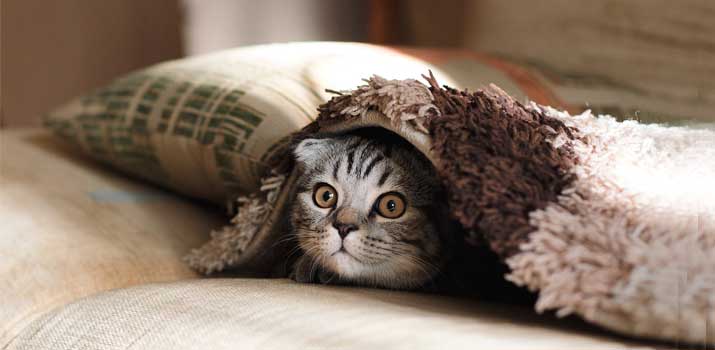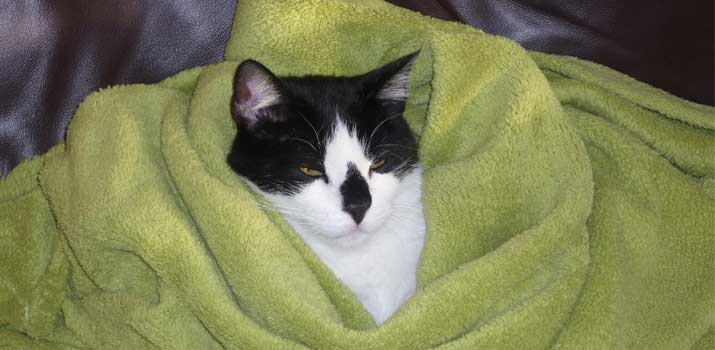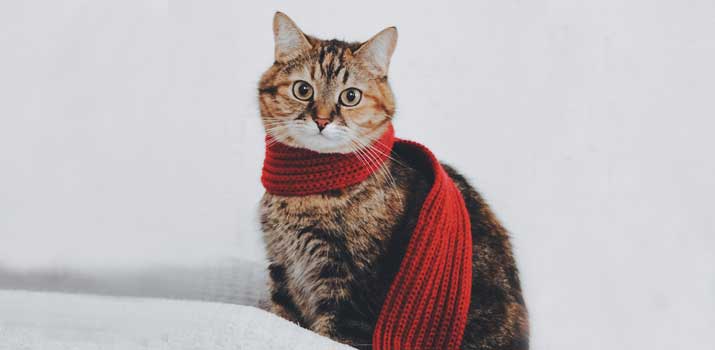
When winter rolls around, and the temperature starts to drop, it’s not just your human family members that need to stay warm.
Your cat is susceptible to hypothermia and frostbite, too. Felines who live outside have the highest risk of problems, but even spoiled indoor cats can get too cold.
It’s important to remember that your cat’s body is very different from yours. While you might feel nice and toasty, your cat could be on the brink of experiencing some major health problems.
So that begs the question: How cold is too cold for cats?
The Ideal Feline Body Temperature
Let’s talk about your cat’s body heat.
A healthy range is between 100.5 degrees and 102.5 degrees. In Celsius, that’s about 38.1 to 39.2 degrees.
You’ll notice that a cat’s body temperature is slightly higher than a human’s, which is supposed to be around 97 degrees Fahrenheit. For this reason, most cats have no issues staying warm in normal household temperatures.
Of course, things can fluctuate. Felines tend to run colder when they sleep, but it’s usually not enough of a drop to warrant any concern.
Setting Your Home to Comfortable Levels
Most homes during the wintertime have ambient temperatures around 70 degrees Fahrenheit with the heat on. That’s the perfect temperature to keep a cat comfortable.
Slight fluctuations here and there will affect their comfort levels just like they do your own. But as long as the temperatures stay around 70 degrees, your cat should be fine.
Anything below that, and you might encounter trouble. More on that soon.
Felines are surprisingly resilient and can tolerate much lower temperatures for short periods. It’s not uncommon to see cats roaming through the snow to catch prey. However, those journeys in colder weather are usually brief.
Long-term exposure to colder environments isn’t good for your cat.
How Cold is Too Cold?
At temperatures between 50 and 60 degrees Fahrenheit, your cat will likely feel too cold for comfort.
They might start seeing heat sources such as a radiator, a blanket, or even lay on or close to you!
Once temperatures drop to 45 degrees, the environment is way too cold for your cat to withstand for more than a few minutes at a time. At 32 degrees, the freezing point, cats can begin to suffer from hypothermia and may even experience symptoms of frostbite!
If you ever find your cat battling the cost, bring them inside as soon as possible and use blankets to warm them up.
Factors That Affect Your Cat’s Reaction to Cold Weather
Around 70 degrees Fahrenheit is the consensus of a comfortable temperature for cats. However, the truth is that many factors contribute to how a feline responds to temperature changes.
These animals come in all shapes, sizes, and fur styles. Like different dog breeds, they experience the world in unique ways.
Here are some of the most common factors that could impact what’s comfortable for your cat.
Age
Cats have to deal with the effects of aging, too. In its prime adult years, a feline is typically better equipped to combat the cold than others falling outside that range.
That means that kittens and senior cats are the most vulnerable.
Kittens don’t have the ability to thermoregulate. As a result, they fail to move to warmer locations when they get too cold.
Meanwhile, senior cats have the deal with how cold temperatures affect the joints. About 90 percent of all cats over the age of ten have arthritis. Cold weather makes the joints stiff and painful, so they tend to be more sensitive to lower temperatures.
Size and Overall Weight

Your cat’s size also plays a role in its reaction to temperature. Spoiled housecats are known for packing on the pounds. While not the healthiest way of living, that extra girth does help combat the cold.
Bigger and heavier cats have more natural insulation. As a result, they can handle more cold than skinny or lean felines.
Fur Type
Fur density and color are other crucial factors to consider. If your feline friend has short fur, there’s a good chance that they’re more sensitive to cold weather.
Shorter fur tends to be thin and less insulating. It provides some level of protection, but it’s nowhere near as much as a cat with long fur.
Believe it or not, dark-colored cats are better equipped to stay warm than light-colored felines. Dark colors like brown and black absorb heat. However, white or orange fur reflects it!
Lifestyle
Finally, you have to take your cat’s lifestyle into account. If your cat is a spoiled feline that lives in the lap of luxury inside your home, it won’t tolerate temperature dips too well.
Don’t be surprised if they have difficulty adjusting to the environment if your heater suddenly goes out!
On the other side of the coin, cats that spend a good amount of time outside can usually handle cooler temperatures without any issues. You’re more likely to see that cats have easy access to the outside through a cat door.

What Happens if a Cat Get Too Cold?
Your cat’s body temperature will steadily decline when the environment gets too cold. Generally, you’ll start to see the signs of discomfort pretty quickly.
Cats will usually seek out other forms of heat to warm up. They might set up shop next to a heater or a radiator. Alternatively, they’ll try to rub on you to harness some of your body heat.
If you have multiple cats in the house, you may see them curl up together to share body warmth.
These behaviors are pretty standard. While not an immediate sign of trouble, take them as a message to crank up the temperature a bit. If your cat cannot warm up, it could encounter some issues.
Once their body temperature dips below 100 degrees Fahrenheit, your cat can experience hypothermia or frostbite.
Hypothermia
Hypothermia is a serious medical condition when your cat’s body temperature drops faster than it can produce body heat.
Basically, it’s a significant decline in temperature that slowly snowballs into many health complications.
At first, the symptoms of hypothermia are pretty mild. You might feel cold skin around the toes and ears where your cat loses the most body heat.
That may worsen to excessive shivering, labored breathing, and general lethargy. Eventually, the heart rate will slow down as the pupils dilate and your cat becomes more catatonic.
Feline hypothermia occurs in three stages, each getting progressively worse than the last.
The first stage occurs when the body temperature is between 90 and 99 degrees Fahrenheit. The first symptoms are muscle weakness, shaking, and the inability to concentrate.
When your cat’s temperature falls to 82 to 89 degrees Fahrenheit, they’re in stage two. Also known as “Moderate Hypothermia,” this is when labored breathing and a lower heart rate begin.
The final stage is known as “Severe Hypothermia.” Here, your cat’s body temperature is below 81 degrees Fahrenheit. A loss of consciousness and potentially irreversible health problems are possible at this stage.
Frostbite
Frostbite is a specific health issue that usually affects cats in snowy areas where ambient temperatures fall to 32 degrees Fahrenheit or lower.
It doesn’t involve core body temperature. Instead, it’s a condition that damages the skin and tissue with poor circulation.
In most cases, it affects parts of the body that already have poor blood circulation. So, tails, ears, and paws are the first parts of the body to suffer. Anything that has prolonged exposure to snow and ice is at risk, too.
When a cat experiences frostbite, it comes suddenly and sometimes takes days to show symptoms. The affected parts become discolored. They can eventually turn black as the tissue dies.
Treating frostbite isn’t easy, so your best bet is to bring your cat into your warm home anytime temperatures are cold enough to cause damage.
What You Can Do to Warm Your Cat Up
If you suspect that your cat is too cold, you can do a couple of things. First, bring them inside and wrap them in a warm blanket for more insulation. Then, you can apply hot water bottles and position them near heat sources.
If the fur is wet, do what you can to dry it. Wet fur can cause hypothermia even if the ambient temperatures are stable. Dry your cat’s coat and raise its core temperature.
You can also encourage them to be active. Running around raises the body temperature naturally, giving your cat the resilience to warm-up independently.
Keeping Your Cat Nice and Toasty
Don’t let the winter blues affect your cat. Keep ambient temperatures inside your home at around 70 degrees Fahrenheit. Limit their exposure to ice and snow, and give them plenty of opportunities to curl up in cozy blankets.
As long as the temperature is stable, your cat should have no problem staying happy and healthy.
Also read: Why Is My Cat Drinking a Lot of Water and Meowing?

